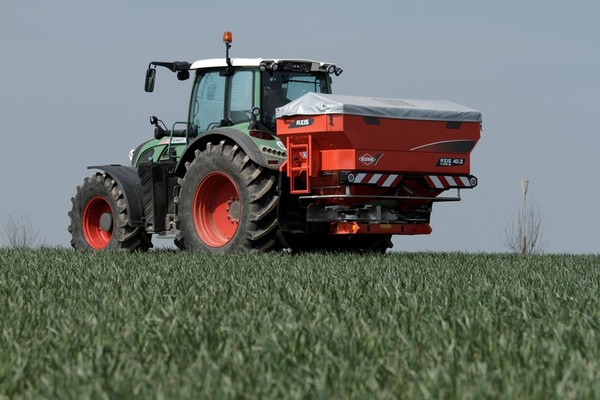
Variable rate fertilizer spreaders
The goal set by the manufacturing industry is not merely the uniform distribution of fertilizer but providing it where it is actually needed and in quantities which are strictly necessary. There are now on the market systems capable of detecting in real time the real requirements of the soil
Other than improving the quantity and quality of production, the profit margin in agriculture is maximized by reducing waste of the production components. A study by the European Commission found that about one million tons of nitrogen are lost per year due to unsuitable methods used for applying fertilizer to create a significant problem not only from the financial point of view but also as regards respect for the environment.
Fertilizer, especially non-organic synthetic types, are traditionally distributed by centrifugal single disc spreaders, or by more modern double disc spreaders, which do not always ensure a satisfactory level of precision in spite of accurate regulation. Perfect uniformity of distribution is difficult to achieve and at times it is necessary to settle for the best compromise among those possible. On the other hand, recent innovations in this area have greatly improved the performance of centrifugal spreaders thanks to the installation of devices which make it possible to increase the flow of fertilizer from the hopper for distribution under real time control. Moreover, efforts are being made to optimize the drop of fertilizer on the rotating disc with radial fins. Thanks to dedicated sensors and an essential CPU, this method now allows the operator to regulate from the cab the work width as well as the real quantity of the product to distribute per unit of surface area. On the successive pass the machine is tuned for operating in PDA (Proportional Distribution in Advance) mode, that is, to the constant kg/ha dose and varying the speed of advance.
The dose becomes variabile
Progress had not come to a stop here. Another goal is to reduce the non-targeted product, with greater care applied to distribution on the sides of the plots, and by using variable rate distribution. To begin, the dose is determined on the basis of georeferenced productivity detected by crop GPS from the previous year during harvest by a combine harvester equipped with yield sensors. The results lead to georeferenced prescription maps of differentiated productivity for planning successive fertilization operations for increasing or decreasing doses according to general agronomic indications of differing areas of land. The fact is that low yield in a certain area may not be fully attributed to a fertilizer deficit but may also be partially or totally due to soil characteristics. For variable rate distribution it is essential for the farm to have available a satellite navigation system and that the parameters for the spreader are properly laid out. For these factors, the tractor should be equipped for ISOBUS compatibility for simplifying the management of the spreader with a single onboard terminal and avoiding the installation of a supplementary CPU. Thanks to the diminishing costs of raw data obtained by satellite or aerial photography by planes, drones or helicopters, precision fertilization has become a consolidated practice. Various models of spreaders have been on the market for some time for variable rate distribution based on vigor mapping of previous crop productivity.
Real time detection
By now, however, differentiation has moved ahead with real time data for evaluating the state of health of crops to include nutritional features, water requirements and general health. Analyses of solar radiation reflected by the crop in an infrared band makes it possible to determine the real needs of the plants down to the smallest areas of plots as detected by the data obtained by aerial photography, planes, drones or helicopters equipped with GPS and dedicated cameras. Detection is also possible via surveillance satellites with orbits of few kilometers compared to 30 to 40,000 km for the GPS network, capable, for example, of calculating the needs of nitrogen on a land area of a few square meters. Another option for spectrum analyses in real time is with the use of suitable optic sensors located on the rear of the tractor. The crop reflection detected is handled by a dedicated CPU on the spreader to direct the machine to variable rate operation. This method simplifies operations with no need for prior preparation of prescription maps. A problem shared by spreaders with double discs equipped with electronic control or not is maintaining good uniformity in transverse distribution varying the drop, an important issue for variable rate operations especially when the fertilizer must be spread on the sides of an area when differential distribution per unit of surfaces is necessary. In this case, it is oppertune to distribute on one of the two sides and reduce spreading or stop it completely on the other. This type of operation is difficult o achieve, especially with an intention to ensure good uniformity. For varying the drop, some manufacturers have modified the drop point for granules on the rotating disc with radial fins allowing it to move closer or away from the center of the plate to speed up the drop of garnules which impact on the fins. Another alternative and opposite option is modulating the rotation regime of the pallets using the hydraulic drive to facilitate choices for the speed of work. Almost all the majors, including Kverneland-Vicon (the manufacturer which pioneered use of the ISOBUS protocol for fertilizer spreaders), Kuhn, Amazone, Bogballe and Sulky, market variable rate centrifugal spreaders. Obviously there are also Italian companies making their mark in this sector. These marketing variable rate spreaders are Damax di Gottolengo (Brescia), Tecnovict in Pianello Val Tidone (Piacenza) and Casella di Carpaneto Piacentino (Piacenza). The latter two also operate in the viticulture and fruit orchard sector.








